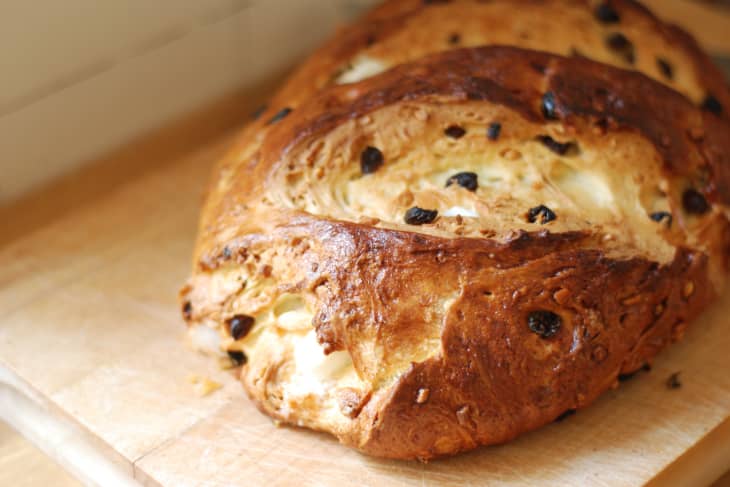Recipe: Easter Bread with Raisins and Sugar Cubes

This gorgeously burnished sweet bread has been an Easter tradition in Aachen, Germany’s westernmost city, since medieval times. Its name is derived from the local dialect’s word for Easter (Posch), combined with Weck, a regional term for white bread rolls. Poschweck therefore simply means “Easter bread.”
Served after the strict Lenten fast, the enriched celebration bread is studded with expensive (and high-calorie) ingredients like raisins and almonds, but what’s really special about Poschweck is the addition of whole sugar cubes, which get kneaded into the dough in addition to the dried fruit and nuts.
This sweet addition makes for slightly unwieldy kneading, but when the loaf bakes in the oven, the sugar cubes partially melt, leaving behind sugar-crusted holes in the crumb, like tiny little geodes. Some sugar cubes stay intact, for an occasional pleasurable crunch as you eat. The interplay of rich yeasted dough and crunchy sugar is not unlike that of Liège waffles. (And, perhaps not surprisingly, the two cities are less than 40 miles apart).
I call for fresh yeast in the recipe because I find that it makes for a particularly flavorful and fluffy crumb. However, if you cannot find fresh yeast where you live, instant yeast can be substituted. The bread will not be quite as exuberantly risen, but it will still taste very good.
Brushed with an egg wash and slashed three times diagonally, the dough bakes up into an impressive loaf. I like to present it as the centerpiece on my Easter Sunday breakfast table, sliced thickly, along with boiled eggs, homemade jams, and sweet butter to gild the lily (although the bread is delicious all on its own). It is best the day it is made, but leftovers can be toasted for a decadent Easter Monday breakfast.
Easter Bread with Raisins and Sugar Cubes (Aachener Poschweck)
Makes 1 (11-inch) loaf
Serves 8 to 10
Nutritional Info
Ingredients
For the loaf:
- 3/4 cup
(100 g) chopped, blanched almonds
- 1 1/2 ounces
(42 g) fresh yeast, or 2 teaspoons instant yeast
- 2 tablespoons
granulated sugar
- 1 cup
(240 ml) whole milk, lukewarm
- 4 cups
(500 g) all-purpose flour, scooped and leveled, plus more for kneading
- 11 tablespoons
(150 g) unsalted high-fat, European-style butter, at room temperature
- 1 teaspoon
vanilla extract
- 2
egg yolks
- 3/4 teaspoon
salt
- 1 cup
(140 g) raisins
- 1 cup
(125 g) sugar cubes
For the egg wash:
- 1
egg yolk
- 1 tablespoon
granulated sugar
- 2 teaspoons
whole milk
Instructions
Place the chopped almonds in a dry skillet and toast over medium-high heat, stirring constantly, until pale golden and fragrant, 5 to 7 minutes. Remove from the heat and set aside to cool.
Crumble the yeast into a medium bowl and add the sugar. Whisk in the milk until the yeast dissolves. Cover the bowl with a dishcloth and set aside for 15 minutes. If using instant yeast, skip this step and simply add the yeast to the flour and other ingredients in the next step.
Place the flour in a large mixing bowl and make a well in the middle. Cube the butter and place in the well. Add the vanilla extract to the yeast mixture and pour and scrape it all into the well. Before mixing, add the egg yolks and the salt. Using your hands, mix everything together and knead in the bowl until the dough comes together. Then scrape out onto a lightly floured surface and continue to knead, adding flour only if necessary, until the dough is smooth, 3 to 5 minutes more. You want the dough to remain as light and floppy as possible, so resist the urge to add additional flour, unless absolutely necessary, for example if the dough still is sticky after several minutes of kneading. The more you knead, the less sticky the dough should become. At the end of kneading, the dough should no longer be sticky. Form into a ball and set aside on the work surface to relax for a few minutes.
Gently roll out the dough until it is about an inch thick. Place the raisins, toasted almonds, and sugar cubes on the surface of the dough. Gather the dough up and around the fillings and knead them in until well distributed throughout the dough. This will be unwieldy at first, but as you keep going, the dough will start to come together again. Form the dough into a ball and put back into the mixing bowl. Cover with the dishcloth and place in a warm, draft-free spot for 1 hour.
After 1 hour, preheat the oven to 350°F/180°C. Line a baking sheet with parchment paper. Gently push down the dough to knead through once, and then shape into a 9-inch-/23-centimeter-long loaf that is about 5 inches wide in the middle. Place on the baking sheet.
To make the egg wash: Whisk the egg yolk with the sugar in a small bowl. Whisk in the milk. Brush the loaf evenly all over with the egg wash. Using a very sharp (ideally serrated) knife, slash the top of the loaf three times diagonally. Set aside in a warm, draft-free spot for 15 minutes.
Bake for 45 minutes, or until the Poschweck is a rich, deep golden-brown and sounds hollow when tapped. Place the sheet on a rack and let the loaf cool completely before serving in thick slices. The bread is best eaten the day it is made, but leftovers can be lightly toasted for a very special next-day breakfast.
